#1788 Pattern
Text

SYBOULETTE'S CANDY NURSERY CONVERTED TO THE SIMS 2 🍭
my previous conversions of syb's nursery sets can be found here: dreamy toddler 👶🏽| little dino 🐱🐉
hi everyone! @syboubou released their candy nursery set some time back in april to celebrate the release of ts4's growing together expansion pack, and i DESPERATELY wanted it for ts2! it's so, so adorable! so i did what i do, and almost two months later... here we are! i'm finally done converting the ENTIRE set! 🥳💃🏽
altogether there are 23 buy items, many of them functional, and 3 build assets: 2 wallpapers, 1 carpet floor. i'm immensely pleased with how it all turned out! it should pair well with my dreamy toddler conversions (linked above) and also my 4t2 conversion of madlen's kei baby care kit!
credits go to @syboubou for the amazing original set! it's simply perfection! 💝
there are two versions in the download below: a merged version, and an unmerged version. yes, the download is just THAT big. please pick only one! a collection file has also been prepared for convenience's sake.
DOWNLOAD: SFS | MF 🧁
keep reading below the cut to read what you need to read! and see what you need to see!
more previews


things to note
a readme.txt is also included in the download!
the changing table does not actually come with a bin. so unless you place the decorative trash bin next to it, your sims will be throwing their trash into the void.
the crib is unanimated. i tried my best but the mapping and the way the model was made simply would not accomodate any animations without looking even worse 😫
the dresser is just decor. i use the gussy up mod in my game so my sims rarely use wardrobes. plus, the original dresser's structure made it impossible to be animated 😅
the way that the playmat works in the previews above is actually as a rug. i made an invisible recolor of the sims 2 store playmat (included in the download) and layered it over the decorative one so that it's 'functional'! if you just want the playmat as a rug, you can delete this.
the toddler bed is cloned from @themediocresulk's toddler beds as pet beds so that it's less buggy and your toddlers can get in or out whenever you want them to! you may want to grab this mod so that they gain more motives.
items included
taken directly from that readme.txt.
buy mode:
Baby Shoes Box -> 318 polys, $49
Beehive Ceiling Lamp -> 900 polys, $99
Bookcase -> 489 polys, $249
Books -> 84 polys, $49
Cat Plushie -> 840 polys, $39
Changing Table -> 349 polys, $249
Cloud Rug -> 2 polys, $49
Crib -> 1788 polys, $399
Diapers Box -> 772 polys, $9
Dresser -> 76 polys, $699
Hanging Plant -> 506 polys, $19
High Chair -> 1048 polys, $249
Mirror -> 270 polys, $149
Ottoman -> 316 polys, $89
Playmat -> 1584 polys, $249
Potty -> 112 polys, $99
Rabbit Lamp -> 912 polys, $35
Rocking Egg Chair -> 1760 polys, $379
Shelves -> 168 polys, $89
Toddler Bed -> 1855 polys, $349
Toy Rattle -> 432 polys, $49
Trash Bin -> 222 polys, $39
Vanity Case -> 1436 polys, $29
build mode:
Floor Carpet -> 26 swatches, $1
Wallpaper Panelling Paint -> 56 swatches, $1
Wallpaper Panelling Pattern -> 32 swatches, $1
misc:
a recolor of the sims 2 store's baby dangle monster playmat is also included. if you want to use it, you'll need the original mesh from the store download.

phew, that was a LONG, but satisfying, post to write! i hope everyone enjoys these conversions as much as i do! i had a lot of fun making them 💝
have a lovely day simming everyone! don't be afraid to reach out to me if there's any issues with this download. though as always, keep in mind...

cheers ~ 🥂
725 notes
·
View notes
Text

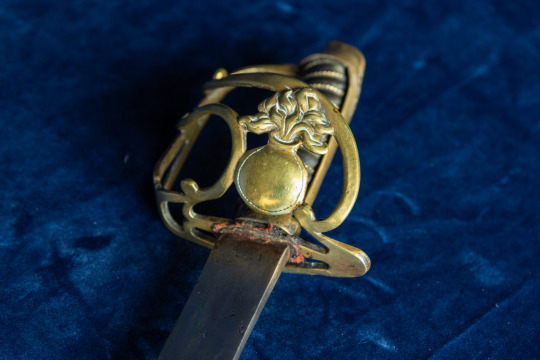

French Grenadier Officers' Sabre - Petite Montmorency style.
Circa 1788 - 1800.
The social upheaval in France during the late 18th century was pervasive through all levels of society. People were abandoning the old and adopting a number of new styles and fashions to display their allegiance to which ever faction the belonged to; the (soon to be executed) king, the revolution, or some variation of the politics at the time.
One of these changes in fashion began around 1784 with infantry officers giving up their model 1767 smallsword in favour of non-regulation sabres, often based on the styles copied from the cavalry. The rotating guard hilts were one such example.
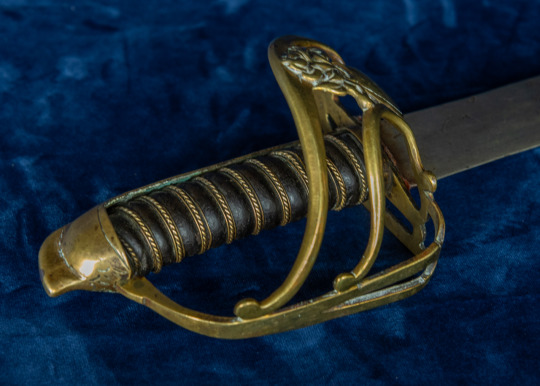
With the Royal decree of April 1788 permitting the use of sabres by the infantry we see another type appear, swords with slotted hilts and sidebars that often feature military emblems such as the light infantry hunters horn or the grenadiers flaming bomb. While others (normally associated with the National Guard) display elaborate political symbolism like Roosters or lions with the Phrygian cap; icons of bravery, the French State and the revolution.
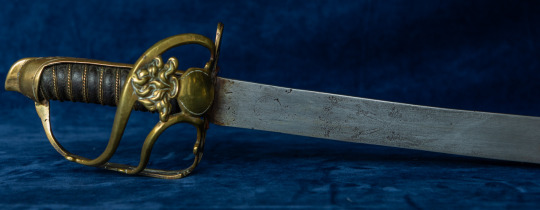
Because these sabres were non-regulation, they don't follow a set pattern; and can be plain or very ornate. Seeking to classify them, collectors of the late 19th Century noted that many swords in this style had blades that matched the profile of the Montmorency Dragoons; a curved blade with a central fuller and a secondary fuller running close to the spine.
Since they were carried by infantry or National Guard officers, on the whole this style of sabre are shorter than the dragoon type, thus earning them the petite montmorency moniker.
As with many such arbitrary names, its meaning has expanded in use to cover a wider group of swords that are broadly similar but don't follow exactly the same features. This sword is such an example. The slotted hilt and guard are very typical with the helmet pommel, sidebars and flaming bomb. However because the blade is has no fuller, it can't be said to have a true montmorency blade. Still, it is the best grouping we have for this sword.
This sword is a handy weapon, just shy of 80cm long with a 66cm blade. The lack of a fuller means is weighs 750 grams, giving it a lot of presence in the hand. The blade engraved with the word Grenadier on one side and flaming bomb with a trophy and bomb on the other; otherwise it is very plain.

On the spine there is an arrow wrapped in a scroll, which I assume to be related to the maker. I'm sure I've seen this mark before but now I can't find the source. If you know what it means, please let me know.

Stats:
Overall Length - 795 mm
Blade Length - 655 mm
Curve - 15 mm
Point of Balance - 140 mm
Grip Length - 142 mm
Inside Grip Length - 105 mm
Weight - 750 grams
#swords#sabres#antique swords#military antiques#napoleonic era#18th Century#French Army#Infantry Officers#Officer Swords#Grenadiers
90 notes
·
View notes
Text
'The War of the Districts, or the Flight of Marat…'
Part 1 (of 5)
Some years ago I photographed a fantastic, satirical poem from a compendium of French Revolutionary verse in the BnF (réserve). It’s been gathering virtual dust ever since. But no more! It’s a witty take on a key moment from early in the Revolution, when the Paris authorities pitted themselves against the radical Cordeliers district (under Danton’s leadership). With help from @anotherhumaninthisworld (merci encore!), we managed to produce a rough translation, which I revised, added some footnotes (to clarify the more obscure references) and added this brief intro to put it in context. While the translation is a literal one, I’ve tried to preserve some of the rhyming spirit of the original where possible. So boil the kettle, get a brew on and settle down to an epic account of Maranton vs Neckerette…
In the early hours of 22 January 1790, General Lafayette, commander of the National Guard, authorized a large military force to arrest the radical journalist Jean-Paul Marat, following a request from Sylvain Bailly, the Mayor of Paris, to provide the Chatelet with sufficient armed force [“main-forte’] to enable its bailiff to enforce the warrant.[1] Bailly’s request was in response to the outrage caused by the publication, four days earlier, of Marat’s 78-page Denunciation of the finance minister, Jacques Necker.[2] Marat had moved into the district the Cordeliers district in December to seek its declared protection against arbitrary prosecution.
His best-selling pamphlet denounced Necker – probably the most popular man in France after the King in July 1789 – of covertly supporting the Ancien Régime and working to undermine the Revolution. His accusations included plotting to dissolve the National Assembly and remove the royal family to Metz on 5 October, colluding in grain hoarding and speculation, and generally compromising the King’s honour. The charges were intended to reveal a cumulative (and damning) pattern of behaviour since Necker’s reappointment in July 1788, and again in July 1789. Bearing his Rousseau-derived epigraph, Vitam impendere vero (‘To devote one’s life to the truth’) – now used as a kind of personal branding, Marat adopted the role of “avocat” to ‘try’ Necker before the court of public opinion.[3] Its general tone came in the context of a wider distrust of international capitalism, with which Necker was closely associated, and which appearted to violate many traditional values.[4] For those interested in the nitty gritty, here’s a footnote explaining why Marat had completely lost faith in Necker.[5]
It caused such a sensation that the first print-run sold out in 24 hours. Most of the radical press hailed Marat’s audacity in challenging Necker’s ‘virtuous’ reputation, while providing invaluable publicity for his pamphlet. The legal pursuit of Marat was largely prompted by the rigid adherence of the Chatelet to Ancien Régime values against the offence of libel (attacking a person in print).[6] I suspect that Marat was hoping a high-profile campaign against Necker would help to establish his name in the public eye by provoking a strong response. However, this was one of the rare occasions when Necker delegated his defence to ‘hired’ pens, providing Marat with valuable extra publicity.
If libel was the main reason for going after Marat, the impetus for pursuit was further motivated by wider political concerns over the extreme volatility that had gripped Paris since mid-December. After pre-emptive popular action in July and October against perceived counter-revolutionary plotting, a new wave of similar rumours was seen by many as a signal that the thermometer was about to explode again. The arrest of the marquis de Favras on Christmas Eve, for allegedly conspiring to raise a force to whisk the King away to safety, assassinate revolutionary leaders, and put his master, Monsieur (the King’s middle brother) on the throne as regent, only served to intensify popular fears. This, combined with the continuing failure to prosecute any royal officers, including the baron de Besenval, commander of the King’s troops around Paris during 12-14 July – who would be acquitted on 29 January for ‘counter-revolutionary’ actions – led to large crowds milling daily outside the Palais de Justice, as the legal action against both men dragged on through January.[7] On the 7th January, a bread riot in Versailles led to the declaration of martial law; on the 10th, a large march on the Hotel de Ville had been stopped in its tracks by Lafayette; on the 11th, there was an unruly 10,000-strong demonstration, screaming death-threats against defendants and judges, in the worst disturbances to public order since the October Days march on Versailles (and the most severe for another year); and on the 13th, tensions were further exacerbated by a threatened mutiny amongst disgruntled National Guards, which was efficiently snuffed out by Lafayette.[8] As a result, Marat’s Denunciation, and earlier attacks on Boucher d’Argis, the trial’s presiding judge, were seen as encouraging a dangerous distrust towards the authorities. Hence the pressing need to set an example of him.
So much for the background. Do we know anything about the poem’s authorship? it appeared around the same time (July/August) as Louis de Champcenetz & Antoine Rivarol’s sarcastic Petit dictionnaire des grands hommes de la Révolution, par un citoyen actif, ci-devant Rien(July/Aug 1790), which featured a brief entry on how Marat had eluded the attention of 5000 National Guardsmen and hid in southern France, disguised as a deserter. These figures would become the subject of wildly varying estimates, depending on who was reporting the ‘Affair’ – all, technically, primary sources! The higher the number of soldiers, the greater the degree of ridicule.[9] Contemporary accounts ranged from 400 to 12,000, although the latter exaggerated figure, included the extensive reserves positioned outside the district.[10] Since the poem also suggests around 5000 men, this similarity of numbers, alongside other literary and satirical clues, such as both men’s involvement in the Actes des apôtres, and the Petit dictionnaire’s targeting of Mme de Stael, suggest a possible common authorship.[11] While the poem took delight in mocking the ineptitude of the Paris Commune, the lattertook aim at the pretensions of the new class of revolutionary. While it is impossible to estimate the public reception of this poem, its cheap cover price of 15 sols suggests it was aimed at a wide audience. It was also republished under at least two different titles, sometimes alongside other counter-revolutionary pamphlets.[12]
Both act as important markers of Marat’s growing celebrity, just six months after the storming of the Bastille. A celebrity that reached far beyond the confines of his district (now section) and readership (which peaked at around 3000).[13] Marat was no longer being spoken of as just a malignant slanderer [“calomniateur”] but as the embodiment of a certain revolutionary stereotype. While he lacked the dedicated ‘fan base’ of a true celebrity, such as a Rousseau, a Voltaire or (even) a Necker, he did not lack for public curiosity, which was satisfied in his absence by a mediatized presence in pamphlets, poems, and the new lexicology.[14] For example, Marat would earn nine, separate entries in Pierre-Nicolas Chantreau’s Dictionnaire national et anecdotique (Aug 1790), the first in a series of dictionaries to capitalize on the Revolution’s fluid redefinition of language.
There seems little doubt that Marat’s Denunciation was intended to provoke the authorities into a strong reaction, and create “quelque sensation”, of which this mock-heroic poem forms one small part.[15] It would prove a pivotal moment in his revolutionary career, transforming him from the failed savant of 1789 to a vigorous symbol of press freedom and independence in 1790. Who knows what might have happened, if, as one royalist later remarked, the authorities had simply ignored this scribbling “dwarf”, whose only weapon was his pen.[16]
I'll post the 3 parts of the poem under #la fuite de Marat. enjoy!
[1] The Chatelet represented legal authority within Paris.
[2] Dénonciation faite au tribunal public par M. Marat, l’Ami du Peuple, contre M. Necker, premier ministre des finances (18 Jan 1790).
[3] The slogan was borrowed from Rousseau’s Lettre à d’Alembert, itself a misquote from Juvenal’s Satires (Vitam inpendere vero = ‘To sacrifice one’s life for the truth’).
[4] See Steven Kaplan’s excellent analysis of the mechanisms of famine plots and popular beliefs in the collusion between state and grain merchants. In part, this reflected a lack of transparency and poor PR in the state’s dealings with the public. During 1789-1790, when anxieties over grain supply were the main cause of rumours and popular tension, Necker made little effort to explain government policies. The Famine Plot Persuasion in Eighteenth-Century France (1982).
[5] As a rule, the King, and his ministers, did not consider the workings of government to be anyone’s business, and was not accountable to the public. However, in 1781, Necker undermined this precedent by publishing his Compte-rendu – a transparent snapshot of the royal finances – yet on his return in 1788, he failed to promote equivalent transparency over grain provision. In consequence, local administrators suffered from a lack of reliable information. Given the underlying food insecurity that followed the poor harvest of 1788, any rumours only unsettled the public. The most dramatic example of this came in the summer of 1789, when rumours of large-scale movements of brigands & beggars created the violent, rural panic known as ‘The Great Fear’. It was Necker’s continuing silence on these matters that lost Marat’s trust.
[6] Necker had a history of published interventions defending himself before the tribunal of public opinion, confessing that a thirst for gloire (renown) had motivated his continual courting of PO, then dismissing it as a fickle creature after it turned against him in 1790. eg Sur l’Administration de M. Necker (1791). For the best demonstration of continuity with Ancien Régime values after 1789, see Charles Walton, Policing Public Opinion in the French Revolution (2009).
[7] The erosion of Necker’s popularity began on 30 July after he asked the Commune to grant amnesty to all political prisoners, including Besenval.
[8] While the evidence was slight, Favras’ sentence to be hanged on 18 February made him a convenient scapegoat, allowing Besenval and Monsieur to escape further action. See Barry M. Shapiro, Revolutionary Justice in Paris, 1789-1790 (1993).
[9] The most likely figure appears 300-500. See Eugène Babut, ‘Une journée au district des Cordeliers etc’, in Revue historique (1903), p.287 (fn); Olivier Coquard, Marat (1996), pp.251-55; and Jacques de Cock & Charlotte Goetz, eds., Oeuvres Politiques de Marat (1995), i:130*-197*.
[10] For example, figures cited, included 400 in the Révolutions de Paris (16-23 Jan); 600 (with canon) in Mercure de France (30 Jan), repeated in a letter by Thomas Lindet (22 Jan); 2000 in a fake Ami du peuple (28 March); 3000 in Grande motion etc. (March); 4000 in Révolutions de France; 6000 (with canon) in Montjoie’s Histoire de la conjuration etc. (1796), pp.157-58; 10,000 in Parisian clair-voyant; 12,000 in Marat’s Appel à la Nation (Feb), repeated in AdP (23 July), reduced to 4000 in AdP (9 Feb 1791), but restored to 12,000 inPubliciste de la République française (24 April 1793).
[11] “Five to six large battalions/Followed by two squadrons” = approximately 5000 men (4800 + 300). A royalist journal edited and published by Jean-Gabriel Peltier, who also appears the most likely publisher of this poem.
[12] For example, Crimes envers le Roi, et envers la nation. Ou Confession patriotique (n.d., n.p,) & Le Triumvirat, ou messieurs Necker, Bailly et Lafayette, poème comique en trois chants (n.d., n.p.). Note the unusual use of ‘triumvirate’ at a time when this generally applied to the trio of Antoine Barnave, Alexandre Lameth and Adrien Duport.
[13] By the time the poem appeared, the Cordeliers district had been renamed section Théåtre-français, following the administrative redivision of Paris from 60 districts to 48 sections on 21 May 1790.
[14] For the growth of mediatized celebrity, see Antoine Lilti, Figures publiques (2014).
[15] As Marat explained in a footnote (‘Profession de foi’) at the end of his Denunciation, “Comme ma plume a fait quelque sensation, les ennemis publics qui sont les miens ont répandu dans le monde qu’elle était vendue…”
[16] Felix Galart de Montjoie, Histoire de la conjuration de Louis-Philippe-Joseph d’Orléans (1796), pp.157-58.
#la fuite de Marat#french revolution#poetry#counter-revolutionary#Jean-Paul Marat#Antoine de Rivarol#Louis de Champcenetz#1790#libel#Jacques Necker#General Lafayette#marat
23 notes
·
View notes
Text

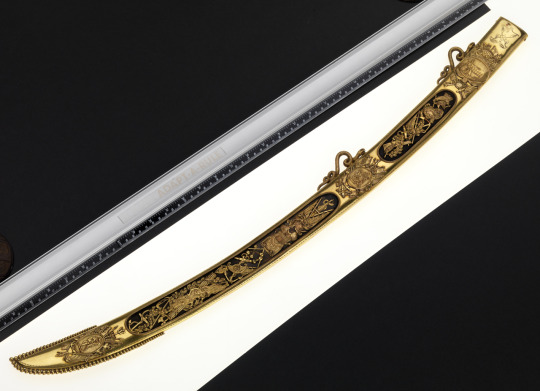
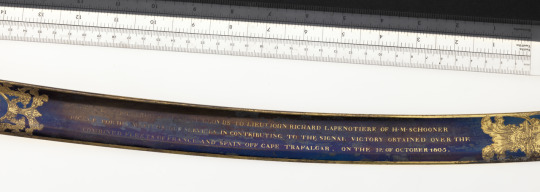

Lloyds Patriotic Fund £100 Trafalgar pattern presentation sword that belonged to Captain J.R. Lapenotiere (1770-1834)
John Richard Lapenotiere entered the Navy in 1780. He served in the South Seas with King George's Sound Company between 1785-1788. He re-entered the Navy when war broke out in 1793. In 'Boyne' under Sir John Jervis at the reduction of the French West India Islands. He was promoted to the rank of Lieutenant in 1794. He commanded the hired cutter 'Joseph' in the Mediterranean between 1800-1803. Whilst in command of the schooner 'Pickle' he rescued the crew of the 'Magnificent', which was wrecked off Brest in 1804.
He commanded the 'Pickle' at the Battle of Trafalgar and was sent home by Vice-Admiral Cuthbert Collingwood (1750-1810) with the dispatches announcing the victory at Trafalgar and the news of Vice-Admiral Horatio Nelson's (1758-1805) death. For this service Lapenotiere was promoted to the rank of Commander and awarded a Lloyd's Patriotic Fund Sword.
He commanded the 'Orontes' at the bombardment of Copenhagen in 1807 and was promoted to the rank of Captain in 1811. He died in Cornwall in 1834.
#naval artifacts#naval weapons#patriotic sword#captain lapenotiere#late 18th -early 19th century#age of sail
90 notes
·
View notes
Photo
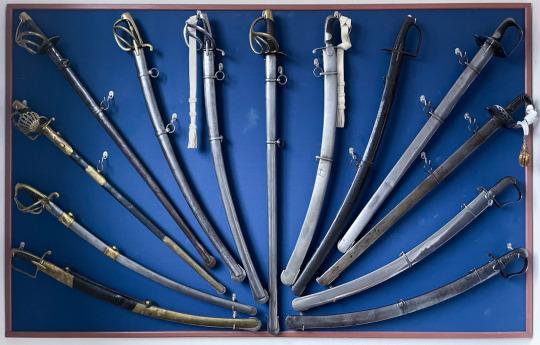
Another re-shuffle of the sword wall. I swapped out the 1796 Pattern heavy cavalry officers dismounted service sword for the 1796 Pattern heavy cavalry officers undress sword. I think this is more in keeping with the other swords which are all trooper swords or officer’s service swords.
The new composition is (from left to right):
- Dutch m1800 Light Cavalry officer’s or NCO’s sabre
- French An XI Light Cavalry officer’s sabre
- French ‘Garde de Bataille’ Dragoon officer’s sword
- French An XIII Heavy Cavalry troopers’ sword
- French An XI Light Cavalry trooprs’ sword
- Dutch m1813 No.2 Light Cavalry troopers’ sabre
- Dutch m1814 No.3 Heavy Cavalry troopers’ sword
- British 1796 Pattern Light Cavalry troopers’ sabre (Dutch issued as the 1813 No.1 for light cavalry)
- British 1788 Pattern Light Cavalry troopers’ sabre
- British 1796 Pattern Heavy Cavalry troopers’ sword
- British 1796 Pattern Heavy Cavalry officer’s undress sword
- British 1796 Pattern Light Cavalry yeomanry officer’s sabre
- British 1796 Pattern Light Cavalry officer’s sabre
#Swords#British swords#Georgian Era#Napoleonic era#Antiques#French swords#Dutch swords#Cavalry swords
107 notes
·
View notes
Text


The Neolithic began at different times, depending on how and when the warming of the Holocene made agriculture viable. While there is some evidence of humans deliberately planting seeds prior to the beginning of the First Agricultural Revolution (another name for the Neolithic), it wasn't until the Holocene that it was practical to shift from a hunter-gatherer type society to a settled agrarian one. Not all people chose to settle, though, such as those in Sub-Sahara Africa and Australia, and there is evidence of people moving between settled and nomadic life styles, depending on local climate. This was the beginning of the type of society that we're more familiar with.[image text]
[slide 1]
Neolithic
about 10,000 BCE to 2000 BCE
Key features: farming, animal domestication, settlements (also known as the Neolithic Revolution or the First Agricultural Revolution
Lasted through the Protodynastic period in Egypt (about 3150 BCE) and the rise of the pre-Shang Erlitou culture in China (about 2000 BCE)
The climate changes of the Younger Dryas cold climate changed to the warmer Holocene
Happened in many places at once, leading to local varieties of plants and animals
Crops in the Levant and Fertile Crescent included wheat, lentils, peas, chickpeas, and flax. In much of Asia, the predominant crop was rice. In the New world, maize and potatoes were the predominant crops.
Animals that were domesticated include dogs, sheep, goats, cattle, and pigs
[slide 2]
Pottery became much more common as people started living in settlements, appearing at different times in each area, often with distinct patterns and decorations being used in an area
Goblekli Tepe build around 9500 BCE - may be the oldest human built center of worship used by nomadic peoples
Remains of figs in Jericho (Tell es-Sultan) dated 9400 BCE- oldest evidence of human cultivated food as figs couldn't be pollinated by insects, but reproduced via cuttings
In Sub-Saharan Africa, development tended toward pastoralism, following herds, rather than settlements.
Crop domestication occurred by 4500 BCE (the Formative Stage) in Mesoamerica, possibly starting as early as 11,000-10,000 BCE (the Archaic Era)
In Australia, a hunter-gatherer lifestyle largely continued until the arrival of the Europeans in 1788 CE, though there is evidence for 'fire farming,' deliberately setting fires to clear underbrush, to open forests for the growth of grasslands, to encourage plants to produce a green flush, to attract and to drive game for hunting
[end image text]
3 notes
·
View notes
Photo





Marbled Monday
This fine Marbled Monday we’ve got this lovely green, yellow, and red marbled treat for you! The actual color of the book in daylight looks more like the first picture shown here, while the second close-up reads a little more grey than it appears in real life.
The book is a facsimile of William Blake’s All Religions Are One published by the Trianon Press in London in 1970. Inside are teeny tiny actual size reproductions of Blake’s etchings, which were originally made in 1788. The etchings were not printed until 1795, however. These reproductions were made from ektachromes, a kind of Kodak film similar to Kodachrome. There are ten plates, each only a few centimeters wide, and accompanying text for each plate at the back of the book. It is thought that the black squares framing the etchings were added later.
The marbling on the covers is dark green and light green/grey splotches with yellow and red veining throughout. This is an example of a Turkish pattern, one of the oldest marbling patterns, in which multiple colors are thrown on the bath using a marbling brush. The colors added later end up more dominant and cause the colors sprinkled on first to become like veining between the blobs of the later colors.
View more Marbled Monday posts.
-- Alice, Special Collections Department Manager
#Marbled Monday#Paper marbling#marbled paper#William Blake#Trianon Press#All Religions Are One#facsimiles#etchings#Ektachrome#Kodachrome#Turkish marbling#Turkish pattern#Alice
64 notes
·
View notes
Text

On this day:
MOON SHADOWS—1912
On January 27, 1912, for nearly four hours, a pitch black "shadow" was observed traveling across the left cusp of the moon. Dr. F. H. Harris guessed that if the distance across the moon's surface was 2,000 miles, then the shadow was 250 miles long and 50 miles wide. The doctor eliminated all probable explanations for the mysterious shadow, which remained "in the shape like a crow poised."
In 1788 a light was observed in the lunar Alps, and then a shadow appeared where the light had been. In 1869, observed from separate U.S. locations immediately prior to a total eclipse of the sun, two groups of seedlike objects marched across the surface of different sections of the moon. The groups moved in parallel lines, but in different directions. In 1882 Connecticut witnesses observed two luminous triangles on the moons upper cusp. After disappearing for three minutes, the shapes reappeared as dark "notches" on the lower cusp, covering practically one quarter of the moon's surface. Between 1892 and 1950, there were a number of reports from around the globe regarding a gigantic shadow traveling horizontally over the moon, "yet it could not be the shadow of any known body."
In the 1950s astronomers in Britain and the United States reported phenomena in lunar craters; two reports concerned a luminous oval near the floor of Aristarchus and a spectacular "bridge-like structure" outline and shadow in Mare Crisium. The latter object had not been there five weeks earlier. A lunar expert in Britain, Patrick Moore, reported that he had distinctly observed the "bridge" for over an hour. Since 1869, the Royal Astronomical Society has recorded over a hundred geometric light patterns visible in Mare Crisium.
Text from: Almanac of the Infamous, the Incredible, and the Ignored by Juanita Rose Violins, published by Weiser Books, 2009
7 notes
·
View notes
Text
youtube
LETTERS FROM AN AMERICAN
January 12, 2024
HEATHER COX RICHARDSON
JAN 12, 2024
Last week, after President Joe Biden went to Valley Forge and then spoke in Pennsylvania, I got a chance to sit down with him to ask a few questions.
What I wanted to hear from him illustrates the difference between journalists and historians.
Journalists are trained to find breaking stories and to explain them clearly so that their audience is better informed about what is happening in the world. What they do is vitally important to a democracy, and it is hard work. One of the reasons I always try to call out the names of journalists whose articles I’m describing is to highlight that there are real people working hard to dig out the stories we all need to know and that we are all part of a community trying together to figure out what’s happening in this country.
Historians do something different than journalists. We study how and why societies change. We are trained to see larger patterns in the facts we find in documents, speeches, letters, and photographs…and in the work of journalists. Some historians believe that mass movements change society, and so they focus on such movements; others believe that great figures change society, and they focus on biographies. Still others focus on economic change. And so on.
In my case, I am fascinated by the way ideas change society, and I am especially interested in the gap between what people believe and what is actually happening in the real world. That interest means that I always want to know how people think and especially how their worldview informs the way they act. Then I compare that worldview to the real-world policies they are putting into place. I sometimes think of what I study as the place where the rubber of ideas meets the road of the real world.
I have twice now been able to interview President Biden. (And let me tell you, it is an odd experience to have your historical subject be able to talk back to you!) The opportunity to ask a historical figure how he thinks, after I have spent years studying his policies, is mind-blowing.
To that end, I wanted to know why he chose to go to Valley Forge, where General George Washington quartered his Continental Army troops for six months in the hard winter of 1777–1788, to start his 2024 presidential campaign. Valley Forge looms huge in American mythology, but most people probably can’t say why. So what did it mean to him to launch his 2024 presidential campaign from there?
I also was deeply interested in what he means when he says he has great faith in the American people—something he says all the time but usually without much context. So what exactly is it about the American people that gives him such faith?
The answers are important, I think, and I found at least one of them surprising.
As I say, it is an odd thing to have a historical subject who can talk back to you, but in all the right ways: it forces you to adjust your understanding of our historical moment. That’s the sort of information that will make the historical record clearer and that, when today’s society has itself become history, will help historians in the future better understand how and why it changed.
LETTERS FROM AN AMERICAN
HEATHER COX RICHARDSON
5 notes
·
View notes
Text
12/6
#24GloPoWriMo
6/4/24
%^%^%^%^%^%^%^%^%^%^%^%^%^%^%^
Prompt Dated : 2024 April 6
Response No : 1
Poem No: 12
%^%^%^%^%^%^%^%^%^%^%^%^%^%^%^
Prompt : Write a poem rooted in “weird wisdom,” by which we mean something objectively odd that someone told you once, and that has stuck with you ever since.
%^%^%^%^%^%^%^%^%^%^%^%^%^%^%^
Featured Poem
Today, our featured participant is Skrol an Yeth, where you’ll find a response to Day 5’s prompt in not just English but Welsh!
ON VANITY
An vanita a dhornskriven
The vanity of a manuscript
nyns yw yn keskerdh hy fraktura,
is not in the march of its blackletter,
mes yn bos kannas unnik an re marow hir alemma.
but in knowing itself the lone envoy of the long-dead.
An golon a arm hy vanita
The heart shouts its vanity
gans kettep pols lorek: y few
with each manic pulse: it lives
(bythkweth ny wodhya ken) hag y hwra bynitha.
(has never known anything but living) and always will.
%^%^%^%^%^%^%^%^%^%^%^%^%^%^%^
Poetry Resource :
Our featured resource for the day is “A Poetry Channel” on YouTube, where you’ll find an eclectic array of poems being read with accompanying images and video.
George Gordon Byron
1788 – 1824
I.
She walks in beauty, like the night
Of cloudless climes and starry skies;
And all that’s best of dark and bright
Meet in her aspect and her eyes:
Thus mellowed to that tender light
Which heaven to gaudy day denies.
II.
One shade the more, one ray the less,
Had half impaired the nameless grace
Which waves in every raven tress,
Or softly lightens o’er her face;
Where thoughts serenely sweet express
How pure, how dear their dwelling place.
III.
And on that cheek, and o’er that brow,
So soft, so calm, yet eloquent,
The smiles that win, the tints that glow,
But tell of days in goodness spent,
A mind at peace with all below,
A heart whose love is innocent!
%^%^%^%^%^%^%^%^%^%^%^%^%^%^%^
Prompt :
Today we’d like to challenge you to write a poem rooted in “weird wisdom,” by which we mean something objectively odd that someone told you once, and that has stuck with you ever since.
Need an example? Check out Naomi Shihab Nye’s poem “Making a Fist.”
Naomi Shihab Nye
1952 –
For the first time, on the road north of Tampico,
I felt the life sliding out of me,
a drum in the desert, harder and harder to hear.
I was seven, I lay in the car
watching palm trees swirl a sickening pattern past the glass.
My stomach was a melon split wide inside my skin.
"How do you know if you are going to die?"
I begged my mother.
We had been traveling for days.
With strange confidence she answered,
"When you can no longer make a fist."
Years later I smile to think of that journey,
the borders we must cross separately,
stamped with our unanswerable woes.
I who did not die, who am still living,
still lying in the backseat behind all my questions,
clenching and opening one small hand.
%^%^%^%^%^%^%^%^%^%^%^%^%^%^%^
Poem Title :
WIERD WISDOM
%^%^%^%^%^%^%^%^%^%^%^%^%^%^%^
Ham Bihari
Udti Chidiya ko
Haldi Lagaana jaantey hain
We, the People of Bihar,
Know how to put turmeric
On the wings of a flying sparrow
I’ve lived in Bihar now for over forty years on end
But ylike a lot of other things that drive me round the bend
I never could quite understand what sparrows here portend
Especially why Bihari friends their living skills extend
To coating with turmeric spice the innocent back end
Of a harmless little chirping bird still trying to ascend
I hesitate ( have hesitated four decades ) to mend
My ignorance by asking if the bird is to be cooked
And if so why not wait a bit the spices for to blend
Or if the bird turns flightless when by turmeric it’s hooked
And if so is the turmeric in powder form or paste
And if I ask for defamation can I not be booked ?
All that I know is this is held to be in great good taste
As final proof that the people of Bihar are most wise
And skilled and not to be dismissed in scorn or thoughtless haste
Wierd wisdom this, to me at least, a pointless exercise
But who am I to disrespect centuries of folklore
Especially when its unravelling I never could devise ?
It’s something that still puzzles me after guesses galore :
Can someone solve this so that I am wiser than before ?
%^%^%^%^%^%^%^%^%^%^%^%^%^%^%^
Poet : Amita Sarjit Ahluwalia
Day 6/12 th Poem
%^%^%^%^%^%^%^%^%^%^%^%^%^%^%^
0 notes
Text


French infantry officers 'Sabre à Garde Tournante'
This is my second 'Sabre à Garde Tournante' which translates to sabre with a rotating guard, referring to the unique side bar that folds in front of the knuckle-bow when not in use.


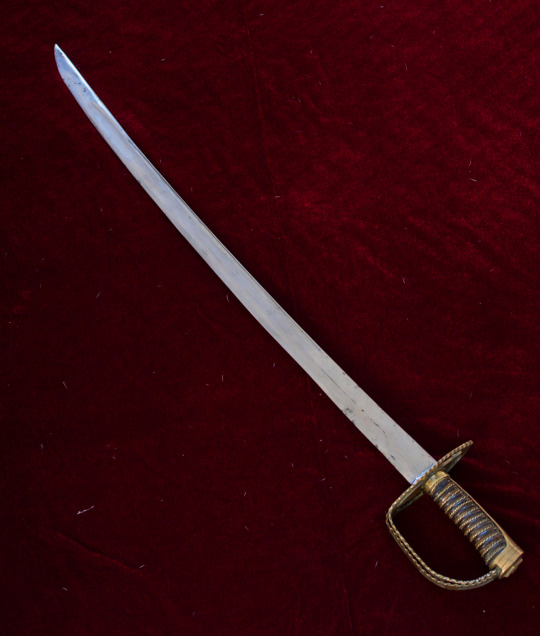
This style of guard became popular in France around 1784 and remained fashionable until about 1800. For a short period the English also followed this trend and they can occassionally be found on 1788 Pattern light cavalry officer swords or 1786 regulation infantry officers swords. But the style faded out with the introduction of the 1796 Patterns. Interestingly Austria actually adopted the rotating guard into their regulation patterns and there it remained in use until the middle of the 19th Century.
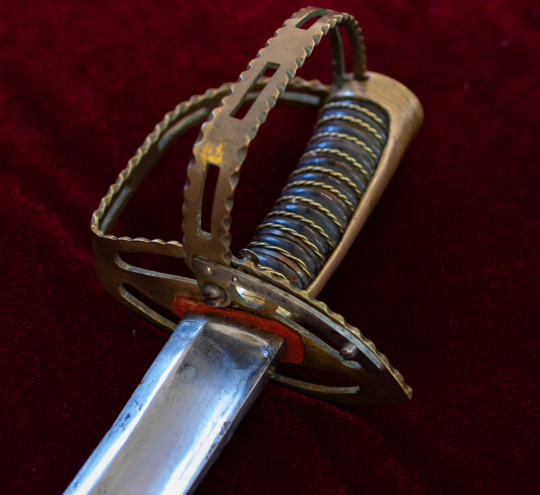
This example has a single side guard that folds out to the outside of the grip that has been scalloped along the edge with a decorative feature that is frequently seen on these swords.

The short blade length and the single frog stud on the scabbard chape mark this as having belonged to an infantry officer of a lower rank who still marched with his men.
Stats:
Overall Length - 765 mm
Blade Length - 740 mm
Curve - 14 mm
Point of Balance - 110 mm
Grip Length - 125 mm
Inside Grip Length - 105 mm
Weight - 610 grams
#sword#sabre#rotating guard#French military#antiques#military antiques#18th Century#napoleonic wars#French swords#Sabre a Garde Tournante
45 notes
·
View notes
Text
Five steps of Wikipedia for Wednesday, 14th February 2024
Welcome, dobrodošli, welcome, velkommen 🤗
Five steps of Wikipedia from "Joint Energy Environment Projects" to "Carl Friedrich Gauss". 🪜👣

Start page 👣🏁: Joint Energy Environment Projects
"Joint Energy Environment Projects (JEEP) is a Ugandan not-for-profit organization that was founded in 1983 by Ruth Kiwanuka after deforestation and soil erosion were identified as major threats to the health and welfare of Ugandans. JEEP's mission is to combat environmental destruction and conserve..."
Step 1️⃣ 👣: Climate
"Climate is the long-term weather pattern in a region, typically averaged over 30 years. More rigorously, it is the mean and variability of meteorological variables over a time spanning from months to millions of years. Some of the meteorological variables that are commonly measured are temperature,..."

Image by NASA
Step 2️⃣ 👣: Adiabatic process
"In thermodynamics, an adiabatic process (Greek: adiábatos, "impassable") is a type of thermodynamic process that occurs without transferring heat or mass between the thermodynamic system and its environment. Unlike an isothermal process, an adiabatic process transfers energy to the surroundings only..."

Image by Eric Gaba (Sting - fr:Sting)
Step 3️⃣ 👣: An Experimental Enquiry Concerning the Source of the Heat which is Excited by Friction
""An Experimental Enquiry Concerning the Source of the Heat which is Excited by Friction" is a scientific paper by Benjamin Thompson, Count Rumford, which was published in the Philosophical Transactions of the Royal Society in 1798. The paper provided a substantial challenge to established theories..."

Image by
Not specified[1][2]
Step 4️⃣ 👣: Antoine César Becquerel
"Antoine César Becquerel (French pronunciation: [ɑ̃twan sezaʁ bɛkʁɛl]; 7 March 1788 – 18 January 1878) was a French scientist and a pioneer in the study of electric and luminescent phenomena. ..."

Image by Petit Pierre (1832-1909) photographe
Step 5️⃣ 👣: Carl Friedrich Gauss
"Johann Carl Friedrich Gauss (German: Gauß [kaʁl ˈfʁiːdʁɪç ˈɡaʊs] ; Latin: Carolus Fridericus Gauss; 30 April 1777 – 23 February 1855) was a German mathematician, geodesist, and physicist who made significant contributions to many fields in mathematics and science. Gauss ranks among history's most..."

Image by Christian Albrecht Jensen
0 notes
Text
The Mining company (LSE: AAL) has a slightly different share-holding pattern than the rest. Famous Institutional investors like BlackRock, Vanguard, and Tarl Investment Holdings. Along with some other institutions, they own about 66% of the total equity. Therefore, the board will likely take into account their preferences.
The Shareholding of Big Leagues
The largest shareholder at the moment is BlackRock, Inc., with 8.5% of shares outstanding. The second and third-largest shareholders are The Vanguard Group, Inc. is at the second, holding 4.4%. and Tarl Investment Holdings, Ltd. is 3.9% of shares outstanding, taking the third place respectively.
Are the Dividends Manipulated?
Considering AAL as a large-cap stock with a market cap of £30B, it’s difficult to claim that institutions manipulate dividends. The company is generating a huge chunk of profits after tax and cash flows that have been optimum recently. The board is distributing close to half of the net income as dividends that account for the current dividend per share of £1.67 and dividend yield of £5.1%.
Technical Analysis and Prediction of AAL Stock Price
In April of 2023, there was a slight rise in prices that gave hope to the bulls. However, the optimism was not for long as bears returned and broke the critical support level of £2509. There was a four-month consolidation period, after which the downtrend gained momentum. It broke through the £226 support level at the beginning of August. It led to the current price levels.
Current price action and prediction
As of this writing, The current trading level for AAL stock price is £2265, and the Bulls have taken control, pushing the price above the current resistance level of £2270. One of the main reasons for this bullish trend is the support provided by the 50-day EMA to the bulls. Currently, the 50-day EMA is at £2203, and it can act as a support level if the bears try to reclaim the resistance level.
The RSI and MACD indicators are both in an uptrend. The MACD is above its neutral line of zero, at 30 while the RSI is above its neutral territory of 50, at 58. The price prediction for the AAL stock price is bullish as the bullish trend is confirmed by the indicators and the RSI has enough space for a breakout.
Conclusion
Big names like BlackRock and Vanguard have the majority shareholding in the company. However, the dividends are not manipulated as the company generates healthy cash. The AAL stock price has just come above its immediate resistance, and the prediction states that a breakout is possible.
Technical Levels
Support: £1995, and £1788
Resistance: £2270, and £2506
0 notes
Video
youtube
BEST Military Cavalry Sword BEFORE the 1788 Pattern?
13 notes
·
View notes
Text
Elevate Your Cake Decorating Game with These Must-Have Tools!

Looking to turn your dream cake into a delicious reality? Look no further!
Sarah Maddison Cookie Stamps: Add that perfect personal touch to your cakes and cookies with these intricate stamps. From lacey elegance to playful characters, Sarah Maddison Cookie Stamps brings your creative visions to life effortlessly.
Satin Ice Fondant: Achieve a flawless cake covering every time with Satin Ice Fondant. Its pliability and range of colors make it a favorite among bakers and decorators. Say goodbye to fondant-cracking nightmares!
Sweet Stamp: Want beautiful lettering and messages on your cakes? Sweet Stamp's letter embossers make it a breeze. Personalize your creations with style and precision.
Sweet Sticks: Take your cake art to the next level with Sweet Sticks. These food-grade pens allow for freehand writing and drawing on your cakes and cookies. Creativity knows no bounds!
Icing Sheets: Turn your cakes into edible works of art with Icing Sheets. Print images, patterns, and designs using edible ink printers. From photos to logos, the possibilities are endless.
Ready to get started? Call us at 03 8759 1788 to order your dream cake essentials. Your cake-decorating journey awaits!
0 notes
Text

How Often Should I Ask For Drain Cleaning?
The frequency of drain cleaning depends on various factors, including the age of your plumbing system, the usage patterns in your household, and the specific needs of your drains. While there is no universal rule, it is generally recommended to schedule drain cleaning on a regular basis to maintain optimal functionality and prevent clogs.
For routine maintenance purposes, it is advisable to have a professional drain cleaning performed at least once a year. This proactive approach helps to remove any build-up of debris, sediment, or potential blockages before they become more severe. By staying ahead of clogs and keeping your drains clean, you can prevent inconvenient backups and maintain a smooth flow of water.
Find Plumberland Emergency Plumbing Land Commerce
Plumberland Emergency Plumbing Land Commerce: https://www.plumberlandla.com
5702 Jillson St, Commerce, CA 90040
XRXV+RR Commerce, California
+1 (747) 245 1788
0 notes